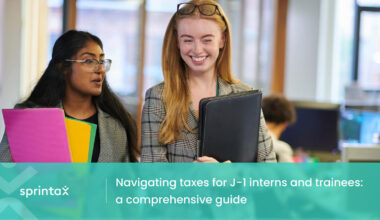Filing taxes in multiple states doesn’t have to be a stress. Here’s everything you need to know about dual state tax filing
In this article you will discover:
- A handy guide to state tax residency
- Who must file multiple state tax returns
- When to file your nonresident state tax return
- How to prepare your non resident state tax return(s) online
COVID-19 turned the world of work upside-down.
Before the pandemic, employees typically worked from a specified place of work. Few had even heard of ‘remote working’, let alone worked from home on a regular basis.
However, the pandemic forced millions of workers in the US to quickly pivot from an office environment to working from home.
As restrictions ease and the world reopens for business, today many workers continue to exercise their choice to take their job on the road and choose their place of work.
But how does working remotely affect your tax situation?
Interestingly a survey conducted by the American Institute of Certified Public Accountants (AICPA) and Harris Poll found that more than 70% of respondents were not aware that working remotely in a state different from their employer’s location can impact their state tax requirements and how much they may owe to each state.
Unsurprisingly, the situation can often be even more complicated for temporary visa holders in the US. (We’re looking at you F-1 and J-1 visa holders!)
So let’s cut to the point – if you’ve earned income in more than one state, or live in one state and work in another, you may need to file more than one state tax return.
In this guide, we’re going to cover the key points a temporary visa holder needs to know about filing tax returns in multiple states.

First things first. Do nonresident aliens have to file a tax return in the US?
Every worker in the US – whether resident or nonresident – is required to file tax documents in the US.
In short, if you earn an income, you must file a federal tax return.
However, even if you do not earn any income during your time in the US, you must still file a Form 8843.
Do nonresidents have to file a state tax return?
In addition to federal taxes, you may also have to pay state taxes depending on where you live and work in the US.
Whether you need to file a state tax return will depend on the tax rules of the state where you are located.
There are nine states which do not impose a state tax: Alaska, Florida, Nevada, New Hampshire, Texas, South Dakota, Tennessee, Texas, Washington and Wyoming.
Sprintax Returns will help you to work out whether you need to file state taxes.
Find out if you have to file a nonresident state tax return
Is my state tax residency the same as my federal tax residency?
Not necessarily…
Tax residency is important because it affects how you are taxed in the US.
In short, a resident alien is treated in a similar manner to a US citizen and taxed on their worldwide income.
Meanwhile, nonresident aliens must pay tax on income earned only in the US (and/or income connected with US trade or business).
Federal tax residency
In order to establish your federal tax residency status, you must take the Substantial Presence Test.
In short, to be considered a resident alien, you must have been physically present in the US on at least:
- 31 days during the current year, and
- 183 days during the 3 year period that includes the current year and the 2 years immediately before that, including:
- All the days you were present in the current year, and
- 1/3 of the days you were present in the first year before the current year, and
- 1/6 of the days you were present in the second year before the current year
It’s important to note that there are certain exceptions to this rule. For example, if you are an F1 or J1 visa student, the first 5 years you spend in the USA do not count towards the Substantial Presence Test. And, if you are a J1 visa holder, the exempt years are 2 of the last 6.
Aside from the Substantial Presence Test, you will also be considered a resident alien if you have a Green Card.
Read more:
State tax residency
Firstly, it’s important to remember that each state has different rules for determining residency status.
So let’s start with some basics.
The address where you permanently live (and include on legal documents to pay taxes, receive social security and bank etc.) will be considered to be the location where you are domiciled.
You may be considered a full-year resident of a particular state if you are domiciled there (you must also spend at least six months living there). If your employer is also located within this state – and you did not live in any other state during the tax year – you will only have state tax return obligations within this state.
Meanwhile, you may be considered a nonresident of a state if you received income from that state, but did not live there for any part of the year.
Finally, you may be considered a part-year resident if you moved to a different state during the tax year.
It’s important to remember that these are the basic rules that are typically applied. However, as a temporary visitor in the USA, some states might treat you differently than others. For example, some states follow federal rules. In other words, if you are considered a nonresident for federal tax purposes, then you will also be considered a nonresident alien for state tax purposes as well – and therefore you will be taxed only on the income you earn in that state.
Meanwhile, some states (including New York, California, Massachusetts and Virginia) review a series of factors in order to verify whether an individual is a resident, part-year resident or nonresident.
True, it can sometimes be complicated for a temporary visa holder to correctly determine their state tax residency status.
The good news is that Sprintax makes this process easy.
Simply create your Sprintax account or login to determine your state tax residency status.
I lived and worked in two different states. Do I have to file dual state tax returns?
While your federal income taxes won’t change depending on where you live, your state income taxes can change.
There are many reasons why you may be required to file tax returns for multiple US states.
Let’s take a look at some examples:
1. You moved home
If you moved home – from one state to another – you may be required to file dual state tax returns.
Depending on how long you have lived and worked in each state, if both states withhold income tax, you may need to pay tax in both states.
2. You live in one state but work in another
If you live in one state and work in another, there are some circumstances under which you will need to file two tax returns.
The good news is that many states have what are known as reciprocity agreements in place.
The purpose of such agreements is to ensure that employees who reside in the relevant state do not have tax withheld from their income in more than one state.
If you’re entitled to benefit from one of these agreements, you will only have to pay state tax in the state in which you live.
However, if no reciprocity agreement is in place, you may have to pay tax in both states.
In both scenarios, depending on your state residency, you might be able to use the taxes paid in one state as tax credit in the other one.
3. You worked remotely in a different state to your employer
Many workers believe that they only need to pay state tax in the state where their place of work is located.
However, this is not always the case.
If you worked remotely and also lived in more than one state during the same tax year, it is likely that you may be considered a part-year resident of the states in which you lived.
In this case, you may need to file multiple tax returns.
When is the deadline to file my tax return?
The deadline to file your federal tax return is 18 April 2022. The same date is also the deadline for most state tax returns except:
- Delaware – 2 May
- Maine – 19 April
- Massachusetts – 19 April
- Virginia – 1 May
What happens if I don’t file my nonresident state tax return?
If you do not file your state tax return you may incur fines or penalties from your local tax office.
As a temporary visa holder in the US, it’s important to have a clean tax record.
If you do not comply with your tax requirements, you may encounter complications should you wish to renew your visa in future.
Can I claim a a state tax refund?
Many temporary visa holders in the US are entitled to claim a refund of their state taxes at the end of the year.
In fact, the average state tax refund a Sprintax customer receives is approximately $400.
However, exactly how much you can claim will depend on your circumstances.

Top tips for filing your state tax return
1. Consider your personal circumstances
When filing your taxes, the first thing you need to do is consider where you lived during the tax year – both permanently and part-time.
Be sure to also jot down the state in which your employer is located.
2. Work out your state tax residency status for each state in which you lived
Remember, there are three types of residency – full-year, part-year and nonresident. Sprintax can help you to determine your residency status for both federal and state tax.
PS: if you can’t remember the dates you traveled in and out of the US, check out our guide here.
3. Collect your income documents
In order to file your documents you will need all of your income forms. This may include forms 1042-S, W2 and 1099. You will also need your Social Security Number and passport.
Can Sprintax help me with multi state tax filing?
You can choose to file your tax documents directly with the IRS and state tax offices.
However, it is difficult enough to file one tax return, it’s even more tricky to file multiple returns!
Sprintax Returns is a software which has been developed specifically to support nonresident aliens with their tax filing requirements.
Sprintax will help you to manage your US tax requirements – including preparation of multiple state tax returns.
Simply create your Sprintax account to get started.
Our user-friendly software will quickly guide you through our tax questionnaire and correctly prepare the federal and state tax documents you need.
So why not prepare your state tax documents online with Sprintax?
Benefits of filing your nonresident tax return with Sprintax
- The best tax software for nonresident aliens in the US
- Automatic generation of completed tax documents including federal, state and FICA tax returns, form 8843, tax return amendments and more
- Your maximum state tax refund guaranteed
- Federal Tax Return E-Filing (1040NR)
- 24/7 Live Chat tax support










